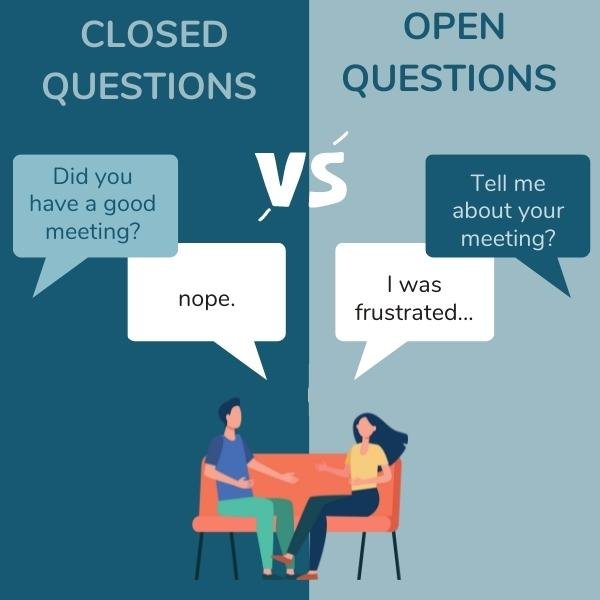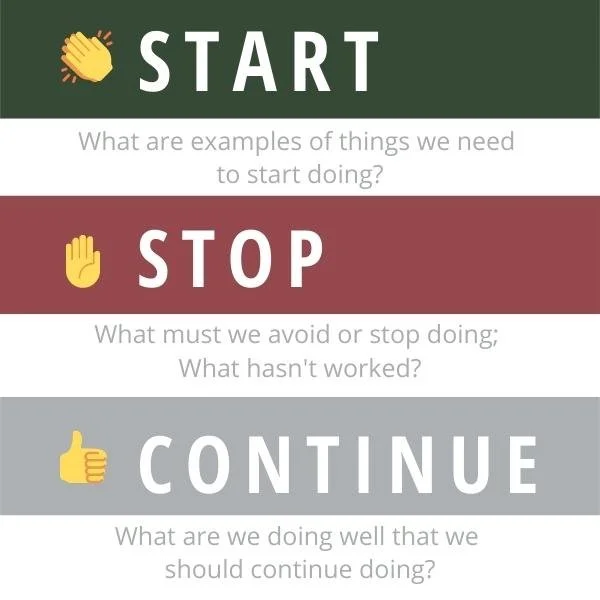What do you need for an effective and engaging team retrospective?
This Articles Learning Goals:
💡Discover (Theory & Framework)
The importance of a retrospective & collecting honest feedback.
🧭 Prepare (Plan & Produce)
How to use boost retrospective engagement and get participants sharing.
🔬 Try (Instructions & Free Templates)
A step-by-step guide to running a compelling retrospective & 4-Retrospective Workshop Ideas.
A room full of people agreeing is the same as silence.
As your Team looks back on the work completed, there are bound to be some successes and failures. So look honestly for areas to learn and improve for future projects. In this article, we’ll look at what makes a good retrospective so you can engage your group in meaningful discussions and reflections.
“I think it’s very important to have a feedback loop, where you’re constantly thinking about what you’ve done and how you could be doing it better.”
💡Discover Retrospective Benefits
The Benefits of an Essential Pause & Reflect
A reflection moment allows you and your team to think about and share how they feel things are going. They give teams space to build trust, raise risks and allow time for mitigation planning and making adjustments to plans on the fly. They are also an excellent forum for celebrating your Team's milestones and accomplishments.
While retrospectives make sense as an end-of-project wrap-up activity, they are highly beneficial when hosted regularly throughout a project lifecycle. Some teams build them as a weekly activity to end their week and look ahead to the next.
Benefits of a Retrospective:
Benefits of a Retrospective:
Promote Transparency
Improve Collaboration
Create Better Features
Reduce Risks
Next, we’ll look at what makes a good retrospective so you can engage your group in meaningful discussions and reflections.
🧭Prepare Retrospective Engagement
6. Simple Tips to Energize Stakeholders
Retrospectives require that the entire group is engaged in the Process. Stakeholders must feel comfortable getting candid. You must set the tone immediately and get your group energized right out the gate.
1. Keep the Format Fresh
Try and keep things fresh so stakeholders are more interested and engaged.
2. Get them Talking.
Everyone in the meeting should speak within the first five minutes. The sooner you engage them, the more comfortable everybody will share. Start with an icebreaker to warm up stakeholders. Then, use open-ended questions to spark conversations.
Free Warm-up Templates
3. Leverage Tools and Templates
Utilizing a structured format on a collaboration tool will engage your stakeholders and signal that this is an important event.
4. Use Open-Ended Questions
An open-ended question will allow you to uncover more than you expect: stakeholders might share triggers you didn't predict and note behaviours previously unnoticed.
An open-ended question will allow you to uncover more than you expect. In addition, inviting people to describe their experiences often reveals surprising problem-solving methods, yearnings, worries, and more.
Here are six open-ended questions to get your team talking:
What would be the value of this to the user?
What business value could this deliver?
How would this add to the experience?
What could be added to improve? What is missing?
How is this different than the current experience?
How do competitors do this? How would they respond?
5. Partner with a Co-Facilitator
Planning and facilitating a retrospective workshop is significant, so pick a few trusted team members to help. Using a co-facilitator to take notes on a shared worksheet allows the leader to stay focused and optimizes the conversation flow.
6. Use an Agenda
An agenda articulates to attendees that you will run the meeting orderly.
Kick-off (Introduce Objective) 5. minutes
Warm-up (Raise participant's energy levels) 5. minutes
Retrospective Activity (The main exercise) 15. minutes.
Wrap-up (key learnings and takeaways) 5. minutes.
First time running a workshop? Check out our blog article on preparing yourself and your participants for workshops.
🔬Try Step-by-step Instructions
Step 1: Table Stakes: Create a safe space for feedback.
A retrospective session will fuel your iterative process and create a safe space for honest feedback. Encourage team members to be open about what went well and what they can improve on the project.
To drive more meaningful conversations in your workshop, create a safe space for participants to engage by
Create a clear structure for the workshop
Give participants a specific role to play
Send out a call for feedback
Align on ground rules
Set Ground Rules
When you start facilitating a workshop, start with a set of ground rules or conversation guidelines so everyone is on the same page. You can use this simple exercise to create rules ahead of the workshop or collaborate with your team to align on a set of rules:
Draw a vertical line separating the whiteboard or collaboration space
Write "Process" and "Norm" on opposite sides
Under Process, collect feedback on how stakeholders will carry out the exercises.
Under "Norms," collect input on how the stakeholders will interact as a group.
Ask everyone to write the rules for interacting in the retrospective (e.g. Norm – everyone should keep their video on).
Examine the compiled list as a group and decide on each rule.
It is best to level-set rules before a retrospective. A level playing field will prevent potential awkward moments that occur when rules are undefined or change through a process.
Step 2: Start on Positive Note,
Provide more assurance to your attendees and lead by example. If team members see you being honest and unafraid to speak the truth, they will also warm up to the idea. In addition, stakeholders will mimic your sincerity and are less likely to be hesitant when it's their time to share, so make sure to moderate the conversation and let quieter voices speak up too.
Honouring success builds team reports and improves cohesion. Start the conversation by reviewing the team's achievements since the last meeting. For example, call out helpful participants who stepped outside their comfort zone, key insights, or completed milestones.
Step 3: Pivot to Constructive Feedback
After recognizing the group's strong performance, it is time to discuss areas where the team can grow and improve. Remember to keep comments constructive as criticism without a suggestion is just complaining and doesn’t do much for inspiring creativity or building trust. Open dialogue will help ensure that the project is successful.
For example: Say a vision statement is not ambitious enough, or maybe someone has bitten off more than they can chew and are late on a deliverable.
Look for lessons that will help improve the next iteration of your project and be supportive if feedback becomes too personal. No one should feel like they need to defend themselves in a retro, and if a conversation gets too personal, you should politely take it offline.
A great little mental model to guide your feedback is the following:
What should we stop doing?
What should we start doing?
What should we continue/do more?
Step 4: Validate Participation
Successfully leveraging the insights from your retrospective is a game changer. Collecting feedback for the sake of feedback can feel nice; however, when problems keep occurring or sh!t hits the proverbial fan, your stakeholders will remember that they raised these concerns without anyone moving the needle.
Identify what lessons are worth taking forward. Some ways to organize your notes include:
Significant: have a measurable impact.
Accurate: factually and technically valid.
Applicable: identifies a specific process or decision that
Reinforces a positive result
Reduces the potential for failure
Sharable: the capacity to highlight knowledge for sharing.
Can the learnings be applied within the stakeholder group, larger team, organization or users?
Step 5: Find a Meaningful Quick Win & Commit
Pin-point attainable lessons for ongoing improvement. Small wins help your group focus on iterative improvement, creating confidence. Vote as a team on the most actionable or meaningful feedback so everyone can align on what to strive for next.
Go Deeper
Try not to take constructive feedback at face value; investigate to get to the issue's root and find the overarching themes.
Commit to Goals
Create inspirational goals and ensure your lessons and takeaways are actionable. A clear direction forward will help build buy-in from outside stakeholders you might need to achieve the goals.
Follow us on Instagram for simple tips to improve your teams, products, and services. Every day we share workshop ideas, practitioner tips, and design inspiration.
✨Bonus: 4 Retrospective Workshop Templates
Steer the Ship
A fantastic way to try and poke holes in a plan to ensure you've covered all angles. It creates confidence among your stakeholders and allows you to plan for the unforeseen.
Buy the Step-by-step Strategic Planning Facilitation Guide: What will guide our ship?
Drive meaningful conversations with teams and stakeholders. Strategic planning activity for risk mitigation. This complete instruction guide helps you lead a collaborative session for launch readiness, retrospectives, and team alignment. Including high-quality, printable templates & expert scripts so you can hit the ground running like a pro.
Step 1 Rocks (risks):
The rocks represent a potential risk or obstacle for your sprint. Unfortunately, these can endure for a long time if your group doesn't find a way to manage them.
Step 2 Anchors (delaying issues):
An anchor keeps a ship in one place, and that's why it represents items that hold your project back. So what impeded your group from making progress?
Step 3 Wind (propelling forward):
Wind moves a ship forward, representing what went well. Next, you'll identify what was quite literally putting wind in your sails.
Step 4 Land (the goal):
Finally, the land is where your ship wants to end up.
The metaphor represents your goal for the project. It can include both long and short-term objectives.
Rose, Bud, Thorn's.
This classic is an easy-to-understand retrospective format to collect honest feedback about the project to date. This tool uncovers hidden values and builds on success while airing concerns. It builds trust among your Team and helps you to take a step back and look at the big picture.
Download Free Rose, Bud, Thorn Template
Step 1: Present Ideas & Concepts
Gather your Team and take turns reviewing inputs to your vision, vision statement, or product/service.
Instruct participants to take notes on their Rose / Bud / Thorns during each presentation.
Step 2: Record Feedback
After each presentation, ask the group to share a rose/bud/thorn.
Capture the feedback by affixing notes or post-its to the whiteboard/chart paper.
Step 3: Debrief
Discuss similarities/differences of participant rose/bud/thorn feedback.
Create new 'buds' by translating your 'thorns' into opportunities and actions.
Prioritize the 'roses' and work them into your product, service, or team vision.
Download Free Rose, Bud, Thorn Template
Retrospective - Google Whiteboard
SWOT
You've probably attended a SWOT analysis – an acronym for strengths, weaknesses, opportunities, and threats.
Review your previous work, identify its strengths and weaknesses, and identify opportunities and threats you can manage.
Follow us on Instagram for simple tips to improve your teams, products, and services. Every day we share workshop ideas, practitioner tips, and design inspiration.
Start, Stop, Continue.
Download Free Start, Stop, Continue Template
A retrospective objective is not only to have a chat – it's about recognizing action items you can use to improve your project. This retrospective tool is excellent for pivoting a conversation into movement.
As a group, review your latest work and identify actions you should start, stop, and continue doing in the future.
Strategic Planner Facilitation Guide: What will guide our ship?
Envisioning user perspectives and behaviours in an empathy map allows your team to align on an in-depth understanding of end users and make informed decisions about how to enhance their experience with your brand.
"What will guide our ship?" Workshop Guide & Template includes:
Workshop outline
Learning goals
Pro facilitation tips and tricks
Step-by-step facilitation instructions
High quality, templates (+printable, slides, & digital whiteboard)
Sample scripts and cues to add to your talk track
Provoking thought starter and discussion questions










